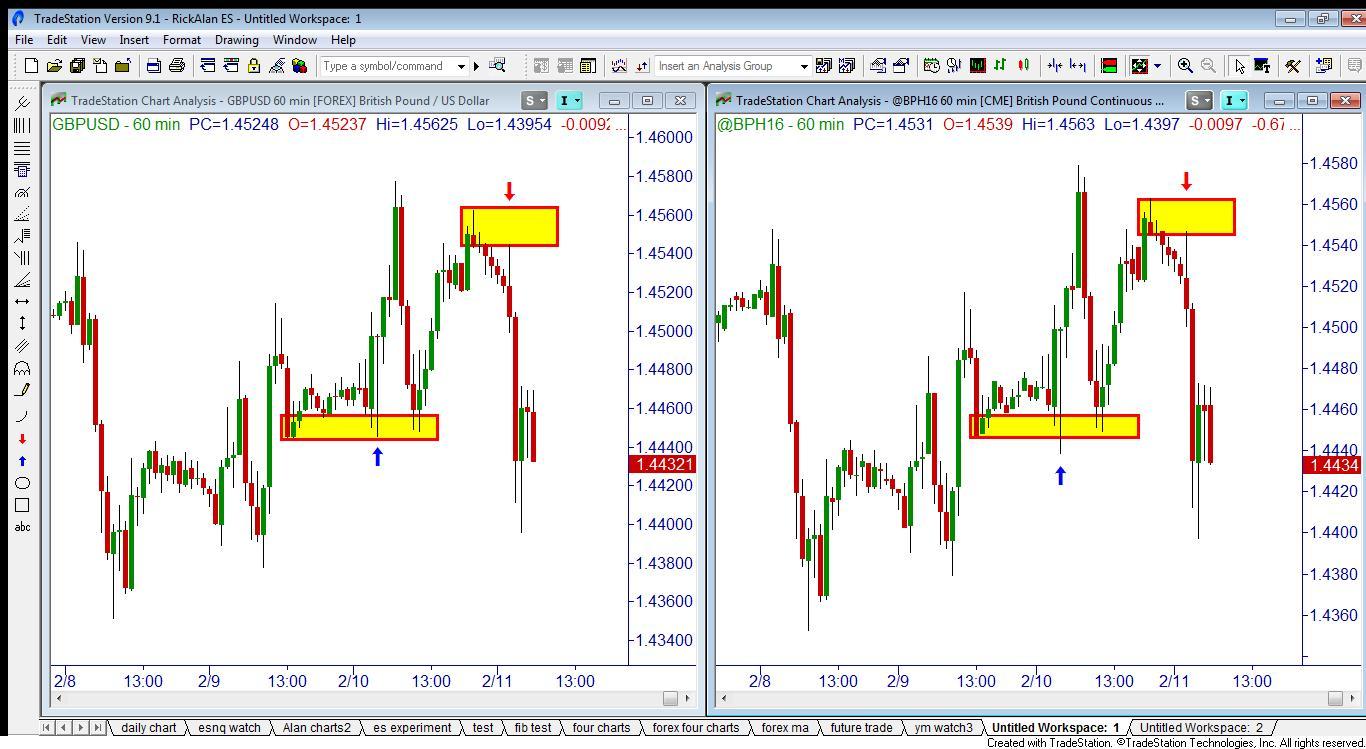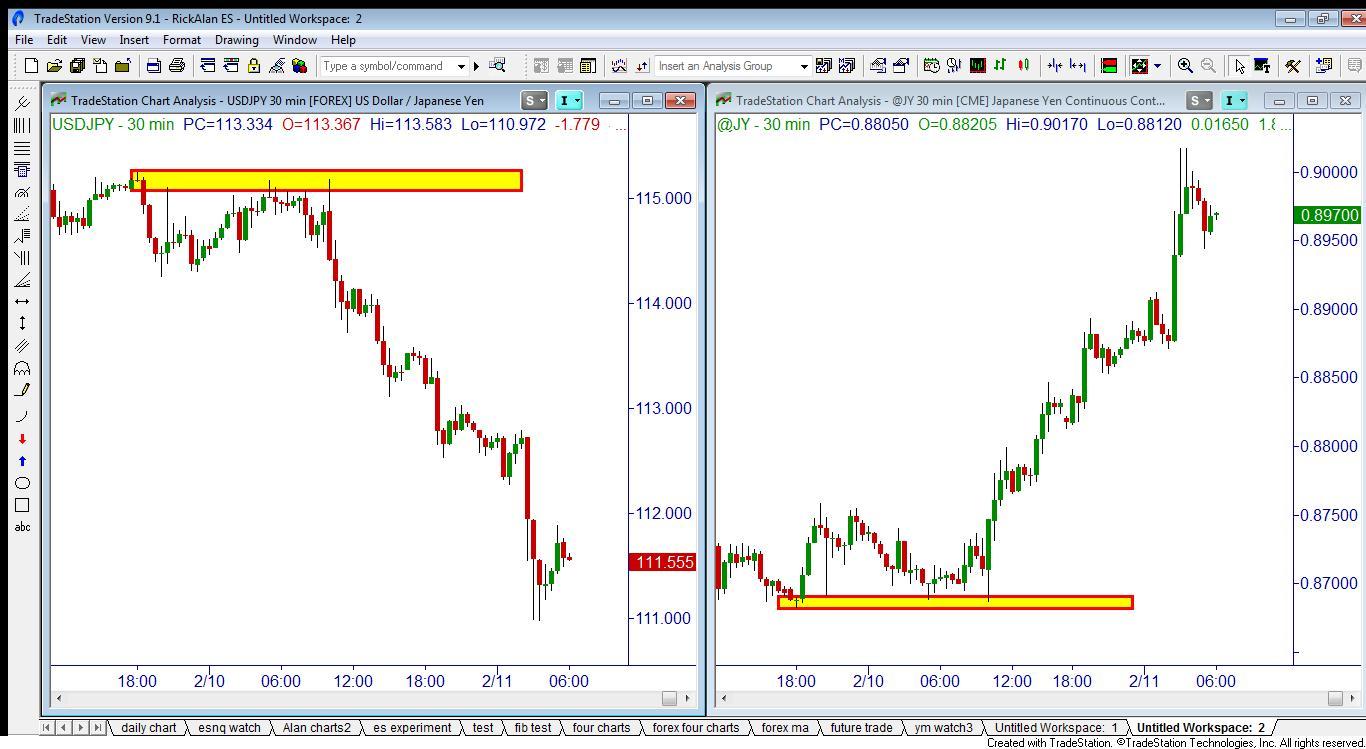
Hello traders! Before we get to this week’s official topic, I’d like to thank each and every one of you that voted for Sam Evans and myself for this year’s FXStreet Forex Best Awards 2016. Once again your votes allowed us to win in the “Best Educational Report” category for our Lessons from the Pros articles. Your votes are much appreciated, and winning again only motivates us more to do even better this year! Thanks again, now on with the official topic!
So last time we discussed the pros and cons of different asset classes. This week I’d like to expand a bit on the differences between trading currencies in the spot market vs. the futures market. Let’s look at a couple of charts first.

In this pair of charts I have the British Pound vs. the US Dollar in both the spot forex market on the left and in the futures market on the right. As you can see, the charts are nearly identical. The glaring difference I’d like to point out is where the two blue arrows are marked. On the spot chart, the GBPUSD did not break down below the marked demand zone, while the futures chart did. Both charts showed a retest of a supply zone which held on both charts, seen where the two red arrows are marked. So what does this mean? It is commonly said that the larger market is more important than the smaller one, and since the spot forex market trades more dollar value per day than the futures market more weight should be given to it. This does lead to a bit of a conundrum, however. With the decentralized market in the spot forex market (explained my last article) how can we “trust” that our broker is showing us the true market? Usually we don’t. I personally prefer to watch my broker’s charts and the corresponding futures market for confirmation. If they don’t line up, such as with the blue arrows, I don’t take the trade. When the markets do line up, check the red arrows again, I will take the trade. Simple as that.
Another thing to note is that these two charts are nearly identical because the British Pound is the base and the US Dollar is the quote. This is not always the case!

In this pair of charts, the USDJPY spot market is on the left while the Japanese Yen futures chart is on the right. Notice anything odd? They are nearly a perfect inverse to each other. This is because in the spot market the USD is the base while the Yen is the quote. When looking at the futures market, basically they are switched; the Yen is the base and the Dollar is the quote. Weird, isn’t it?
Noticing that the USDJPY had a small supply zone while at the same time the Yen futures chart was in demand could have led you to take a trade on either symbol because they both lined up. This is another type of confirmation for those of you who like that sort of thing.
Another small thing on the charts I’d like to point out is the prices. On the GBPUSD / BP chart, notice the slight difference in the actual prices quoted. Now look at the USDJPY / JY chart. Obviously with an inverse chart the prices will be wildly different, this is merely an easy math equation. I don’t really care what the prices are; I just want the charts to match as far as supply and demand. Keeping it simple is my preference!
Another interesting difference in spot forex vs. futures forex trading is the cost (or margin) that it takes to place an actual trade. When trading the GBPUSD, for example, your broker will probably require you to have 2% of the trade value in your account to place the trade. If you are planning on doing one standard lot, 100,000 value of the base currency, you would need about $2890 of US dollars in your account to place that trade. If you were to buy one contract of the BP your broker might charge you only $2035. So, futures can be cheaper to trade! Settle down though. With the GBPUSD, each pip will be worth $10. In the futures market, which trades in ticks instead of pips, the tick value for one contract of the BP is only $6.25. As you may know from your previous trading, not every pair has the same value per pip, which is the same in the futures market. So the big take away here is that different symbols will have different margin requirements, and they will also have different dollar values on the minimum moves (pips or ticks.)
The last difference we’ll discuss this week is an expansion of something briefly mentioned in the last article. Many traders will choose to open one account to trade one asset class, be it spot forex or futures. If you choose to open a forex account only, you will have access to many different currency pairs to choose from. These pairs range from the Major currency pairs including the EURUSD, AUDUSD, USDCAD, all the way to some of the more obscure pairs like the EURPLN (EURO vs the Polish Zloty). While these obscure pairs might look good to you on a spot forex chart, trying to trade them in a futures account might be a problem. The main reason is the lack of volume, or even possibly the lack of the pair even trading in the futures market! If you choose to open a futures account, you will have access to the major currency pairs, in addition to other contracts like wheat, gold, oil, etc. But access to all of the currency pairs will be limited.
So there you have it traders! A few expanded differences on spot forex vs. futures forex trading. Personally, I trade both asset classes as I like the benefits that they both have to offer! As always, please do your own research on your chosen broker to determine what is right for you and your circumstances; even ask your Online Trading Academy Education Counselor for their recommendation.
This content is intended to provide educational information only. This information should not be construed as individual or customized legal, tax, financial or investment services. As each individual's situation is unique, a qualified professional should be consulted before making legal, tax, financial and investment decisions. The educational information provided in this article does not comprise any course or a part of any course that may be used as an educational credit for any certification purpose and will not prepare any User to be accredited for any licenses in any industry and will not prepare any User to get a job. Reproduced by permission from OTAcademy.com click here for Terms of Use: https://www.otacademy.com/about/terms
Editors’ Picks
EUR/USD retreats toward 1.0850 on modest USD recovery

EUR/USD stays under modest bearish pressure and trades in negative territory at around 1.0850 after closing modestly lower on Thursday. In the absence of macroeconomic data releases, investors will continue to pay close attention to comments from Federal Reserve officials.
GBP/USD holds above 1.2650 following earlier decline

GBP/USD edges higher after falling to a daily low below 1.2650 in the European session on Friday. The US Dollar holds its ground following the selloff seen after April inflation data and makes it difficult for the pair to extend its rebound. Fed policymakers are scheduled to speak later in the day.
Gold climbs to multi-week highs above $2,400

Gold gathered bullish momentum and touched its highest level in nearly a month above $2,400. Although the benchmark 10-year US yield holds steady at around 4.4%, the cautious market stance supports XAU/USD heading into the weekend.
Chainlink social dominance hits six-month peak as LINK extends gains
-637336005550289133_XtraSmall.jpg)
Chainlink (LINK) social dominance increased sharply on Friday, exceeding levels seen in the past six months, along with the token’s price rally that started on Wednesday.
Week ahead: Flash PMIs, UK and Japan CPIs in focus – RBNZ to hold rates

After cool US CPI, attention shifts to UK and Japanese inflation. Flash PMIs will be watched too amid signs of a rebound in Europe. Fed to stay in the spotlight as plethora of speakers, minutes on tap.
RECOMMENDED LESSONS
Making money in forex is easy if you know how the bankers trade!
Discover how to make money in forex is easy if you know how the bankers trade!
5 Forex News Events You Need To Know
In the fast moving world of currency markets, it is extremely important for new traders to know the list of important forex news...
Top 10 Chart Patterns Every Trader Should Know
Chart patterns are one of the most effective trading tools for a trader. They are pure price-action, and form on the basis of underlying buying and...
7 Ways to Avoid Forex Scams
The forex industry is recently seeing more and more scams. Here are 7 ways to avoid losing your money in such scams: Forex scams are becoming frequent. Michael Greenberg reports on luxurious expenses, including a submarine bought from the money taken from forex traders. Here’s another report of a forex fraud. So, how can we avoid falling in such forex scams?
What Are the 10 Fatal Mistakes Traders Make
Trading is exciting. Trading is hard. Trading is extremely hard. Some say that it takes more than 10,000 hours to master. Others believe that trading is the way to quick riches. They might be both wrong. What is important to know that no matter how experienced you are, mistakes will be part of the trading process.
